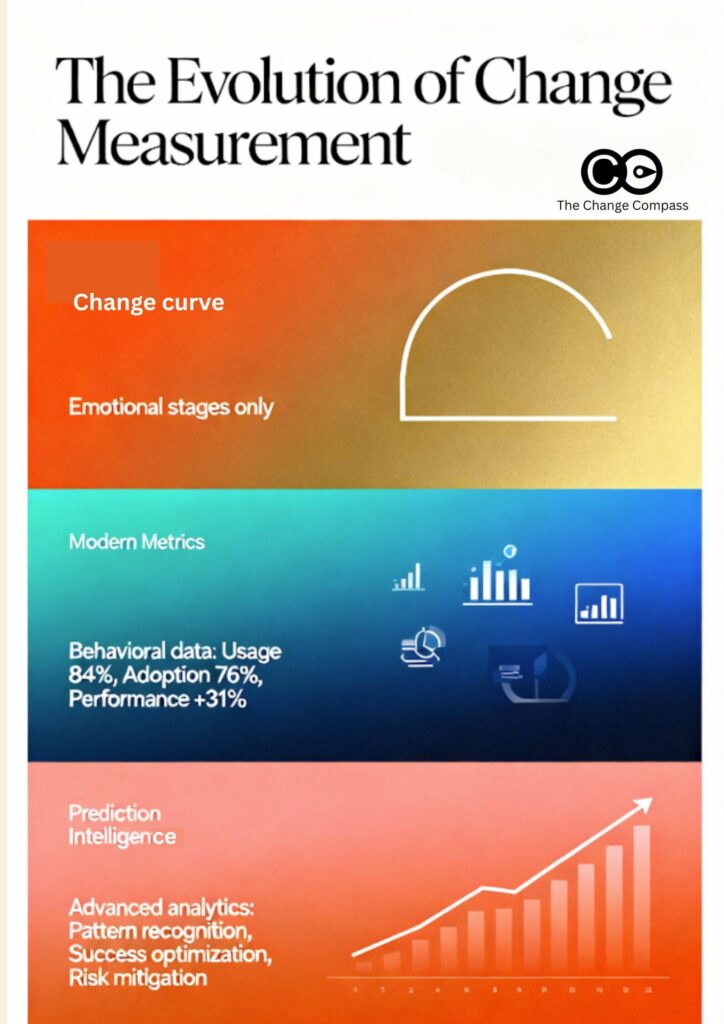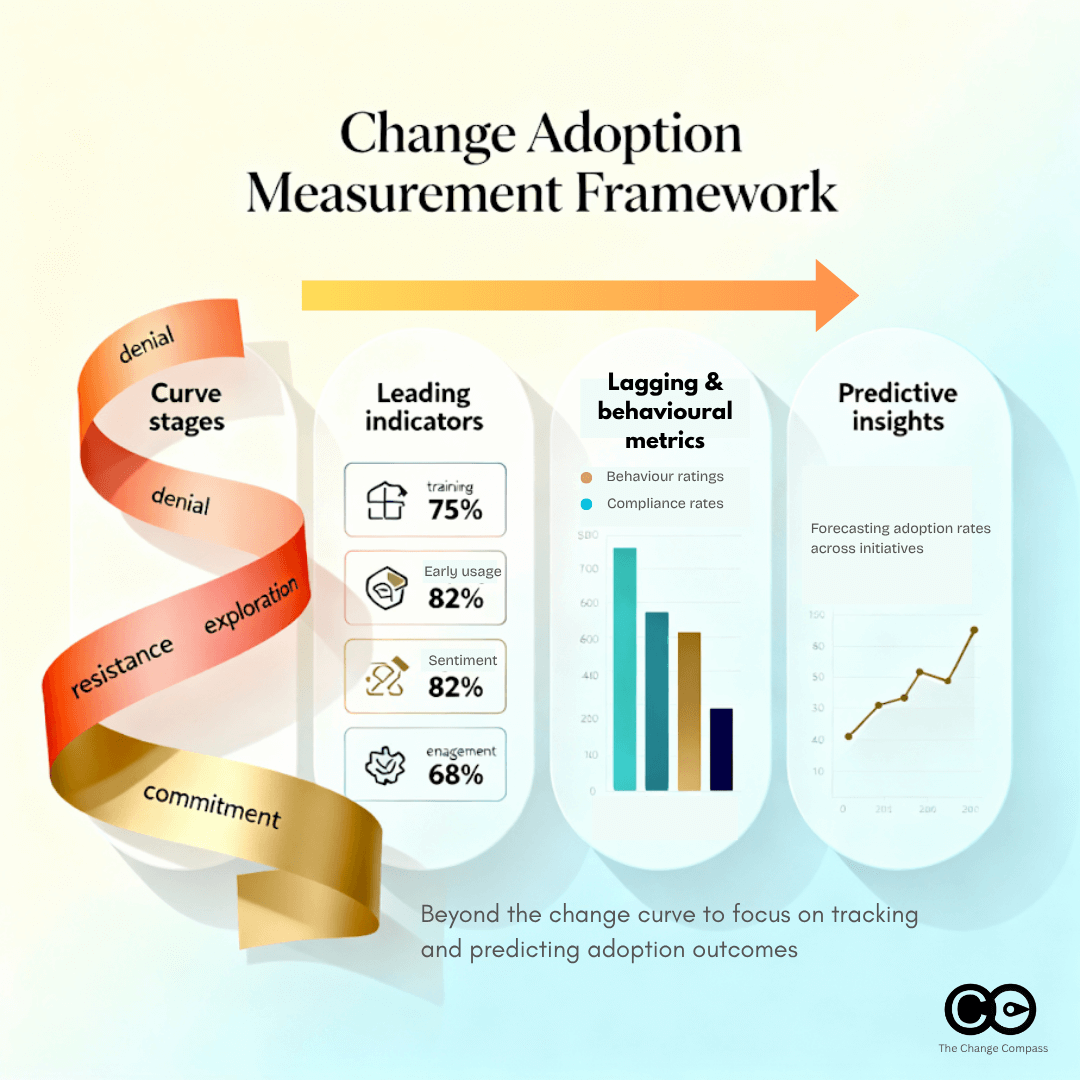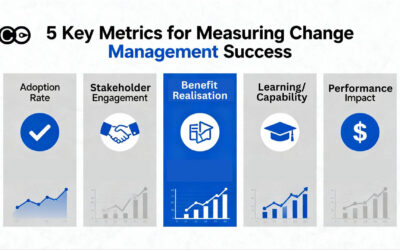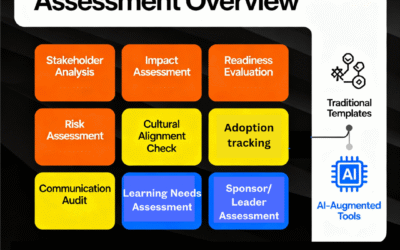Understanding how people navigate through organisational change has been a cornerstone of effective change management for decades. The change management curve, adapted from Elisabeth Kübler-Ross’s work on grief, provides valuable insights into the emotional journey individuals can experience during transformation. However, measuring change adoption requires more than simply mapping people’s positions on this curve – it demands a sophisticated understanding of behavioural indicators, performance metrics, and the complex realities of modern organisational change in organisations.
The relationship between the emotional stages of change and measurable adoption outcomes is both nuanced and critical to transformation success. While the change curve offers a framework for understanding emotional responses within your change management framework, measuring change management effectiveness requires concrete, observable indicators that demonstrate whether people are actually embracing new ways of working rather than merely progressing through emotional stages.
This guide explores how to measure change adoption effectively within the change management curve. We’ll examine when the curve provides valuable guidance, when it may mislead practitioners, and how to build robust measurement frameworks that capture the true indicators of change management success in complex organisational environments.
Understanding the change management curve
Origins and validation of the model
The change management curve emerged from Dr. Elisabeth Kübler-Ross’s 1969 work “On Death and Dying,” which outlined five stages of grief experienced by terminally ill patients. Change management practitioners adapted this psychological model to explain how individuals respond emotionally to organisational transformations as part of change management theory.
Recent research by Hagemann and Cechlovsky (2024) provides empirical validation of these stages in business environments, demonstrating that “individuals manifest akin responses within their respective phases of the change curve, amenable to effective facilitation through judicious interventions”. The study identified four validated phases that consistently appear across different project contexts: Unawareness & Denial, Discomfort & Resistance, Exploration & Discovery, and Integration & Commitment.
Multiple studies have validated the existence of the change curve in organisational contexts, including research from The University of Alabama (1999), “The Death Valley of Change” study (2002), and Finnish-American research (2010). However, the research also reveals important limitations. The curve is not universally applicable, and individual experiences vary significantly. Some people adapt faster than others, and some may not even go through all the stages.
To read up more research about change adoption check out The Science of Change Success: What Research Shows About Predicting Change Adoption.
When the change curve is useful for understanding adoption
Appropriate contexts for curve application
The change management curve proves most valuable in specific organisational contexts where emotional processing plays a central role in adoption success within your change management approach. Research indicates that the curve is particularly effective when changes require significant behavioural change management, involve loss or disruption of familiar systems, affect deeply held values or practices, or create uncertainty about job security or role changes.
Complex system implementations, organisational restructuring, cultural transformations, and compliance initiatives that alter fundamental work practices represent ideal applications for change curve analysis as part of your change management methodology.
Individual-level emotional support and resistance prediction
The change curve excels at providing frameworks for individual emotional support during transformation. Understanding where individuals are positioned on the curve enables “effective facilitation through judicious interventions” as part of comprehensive change management techniques. Someone in the denial phase requires different support than someone in the exploration phase.
When the change curve should not be used
Linear progression and high-performing environments
One of the most significant limitations of the change curve emerges from assumptions about linear progression through stages. Modern research demonstrates that “these stages are not always sequential and that everyone can progress through them differently”. Individuals may skip stages, move backwards, or experience multiple stages simultaneously. (Revisiting the change curve: A rigorous examination and three case studies prompting a re-evaluation of a timeless concept)
Recent research reveals that the characteristic “dip” in the change curve may not occur in environments with the right conditions. As noted by Leopold and Kaltenecker (2015), the performance dip primarily occurs “when the change necessitates that people in the organisation have to unlearn old behaviours, processes and systems and learn new ways of doing things”.
In organisations with strong change management capabilities, high psychological safety, clear communication, and adequate support systems, individuals may transition through change without experiencing significant emotional disruption. High-performing teams with previous positive change experiences may demonstrate change readiness that bypasses traditional curve patterns entirely.
Complex organisational and technology-driven changes
The change curve focuses on individual emotional responses but fails to address the systemic complexities of modern organisational change. Large-scale transformations involving multiple interdependent systems, cross-functional teams, and varied stakeholder groups require change analysis beyond individual emotional processing.
Contemporary changes often involve agile change management approaches, iterative implementations, and continuous adaptation that don’t align with the discrete stages suggested by the curve model. Additionally, not all organisational changes trigger the emotional responses that the change curve addresses. Technology upgrades with minimal workflow impact or process optimisations may not generate significant emotional responses, and attempting to apply curve-based interventions to these situations may misdirect resources away from practical adoption barriers.
Key elements of measuring change adoption
Behavioural indicators vs emotional stages
Effective change adoption measurement requires distinguishing between emotional processing and actual behavioural change. While the change curve tracks emotional responses, adoption measurement must focus on observable actions that indicate genuine integration of new ways of working.
Behavioural indicators provide concrete evidence of adoption success:
• System usage frequency and feature utilisation patterns
• Process compliance rates and quality measures
• Performance metrics showing improved outcomes
• Workflow integration demonstrating seamless adoption
• Knowledge sharing and collaborative behaviours using new tools or processes
These indicators offer more reliable adoption insights than emotional assessments because they reflect actual implementation of change rather than feelings about change.
Leading vs lagging adoption metrics
Comprehensive change adoption measurement requires understanding the distinction between leading and lagging indicators as part of change management KPI frameworks.
Leading indicators include training completion rates and competency assessments, early system usage patterns, stakeholder engagement in change management activities, feedback sentiment and change champion activity.
Lagging indicators encompass sustained performance improvements, full workflow integration, business outcome achievement, long-term retention of new behaviours, and customer satisfaction improvements.
Quantitative and qualitative approaches
Quantitative metrics provide objective, measurable data about change adoption progress using change management analytics. Essential metrics include adoption rate (percentage of target users actively using new systems), time-to-adoption, usage frequency, feature utilisation, compliance rates, and performance measures showing productivity and quality improvements.
While quantitative metrics provide measurable outcomes, qualitative assessment offers crucial context about adoption barriers, user experience, and sustainability factors through stakeholder interviews, change management surveys, observational studies, feedback sessions, and case studies. These approaches reveal the “why” behind quantitative patterns and inform targeted interventions.
To read more about measuring change across multiple initiatives check out Measuring Change Adoption Across Multiple Initiatives and How to measure change adoption.
Building comprehensive adoption measurement frameworks
Multi-dimensional measurement approach
Effective change adoption measurement requires frameworks that capture multiple dimensions of change simultaneously. Comprehensive measurement examines adoption across people, process, and business dimensions.
People metrics focus on individual and team change readiness, capability development, and engagement levels. Process metrics examine how well new workflows and systems are being integrated into daily operations. Business metrics demonstrate the ultimate value delivery of change initiatives through improved outcomes, cost savings, and strategic objective achievement.
Technology-enabled measurement platforms
Modern change adoption measurement benefits significantly from technology platforms that automate data collection, provide real-time insights, and enable sophisticated analysis as part of change management tools and techniques.
Technology advantages include real-time data collection from system usage and user interactions, automated reporting that reduces manual effort, predictive analytics that identify adoption risks, change management metrics dashboard visualisation, and integration capabilities that combine data from multiple sources.
Check out our article on Designing a change adoption dashboard.
Continuous monitoring and adjustment
Change adoption measurement must be ongoing rather than episodic to capture the dynamic nature of adoption processes through effective change monitoring. Continuous monitoring approaches include weekly usage analytics, monthly adoption reviews, quarterly deep-dive analyses, and real-time alert systems flagging significant adoption issues.
This approach transforms measurement from a retrospective assessment tool into a proactive management capability that drives ongoing change management success.
Integration of change curve insights with adoption metrics
Combining emotional and behavioural indicators
The most effective change adoption measurement approaches combine insights from the change management curve with concrete behavioural metrics. This integration provides both emotional intelligence about stakeholder experience and objective data about adoption progress as part of comprehensive change management best practices.
Integrated measurement frameworks track emotional indicators showing curve progression alongside behavioural metrics demonstrating actual adoption, satisfaction and confidence measures correlated with performance and usage data, and resistance patterns identified through curve analysis combined with compliance and engagement metrics.
Using curve insights to interpret adoption data
Change curve insights provide valuable context for interpreting adoption metrics. Understanding emotional progression helps explain adoption patterns and guides appropriate responses to measurement findings.
For example, decreased system usage during early implementation phases may reflect curve-predicted resistance rather than system problems, requiring different interventions than technical issues would warrant. Similarly, rapid adoption by some users may indicate curve bypass rather than universal success, suggesting need for continued support of others still processing emotional aspects of change.

The Change Compass approach to predictive adoption intelligence
Beyond measurement to predictive insights
The Change Compass platform represents the next evolution in change adoption measurement, moving beyond traditional tracking to provide predictive and prescriptive intelligence that transforms how organisations approach change management. Rather than simply reporting what has happened, The Change Compass uses sophisticated analytics to forecast adoption trajectories and identify the factors that drive successful adoption across different contexts.
This predictive capability addresses one of the fundamental limitations of traditional change management tracking: the reactive nature of insights that arrive too late to inform proactive intervention. The Change Compass enables organisations to identify adoption risks weeks or months before they manifest, providing the lead time necessary for effective mitigation strategies.
Data-driven adoption forecasting
The Change Compass leverages historical change management data combined with current adoption indicators to generate accurate forecasts of adoption rates across different stakeholder groups, timeframes, and change contexts.
Forecasting capabilities include:
• Adoption rate predictions by stakeholder group, showing expected adoption curves over time
• Risk identification highlighting specific individuals, teams, or business units likely to struggle with adoption
• Timeline accuracy providing realistic estimates for achieving adoption milestones
• Resource requirement forecasting predicting support needs throughout the adoption journey
• Outcome probability estimating likelihood of achieving intended business results
These predictions enable change managers to allocate resources proactively, adjust timelines realistically, and design interventions that address predictable challenges before they impact outcomes.
Pattern recognition for adoption success factors
Beyond forecasting adoption trajectories, The Change Compass identifies the specific factors that enhance or inhibit adoption success within your organisational context. Through analysis of multiple change initiatives over time, the platform recognises patterns that distinguish successful adoption from failures.
Pattern analysis can reveal:
• Stakeholder characteristics associated with rapid adoption (previous change experience, role types, team dynamics)
• Intervention effectiveness showing which change management techniques produce the best outcomes in different contexts
• Environmental factors that accelerate or impede adoption (organisational culture, leadership support, resource availability)
• Optimal timing patterns for training, communication, and support activities
• Threshold indicators signalling when adoption has achieved sustainability
This intelligence transforms change management from an art based on intuition to a science informed by evidence. Instead of relying on generic best practices, organisations can implement strategies proven effective within their specific environment.
Contextual intelligence for targeted interventions
The Change Compass provides contextual intelligence that enables precisely targeted interventions rather than generic approaches. By understanding how to measure change management success factors specific to different stakeholder groups, the platform recommends interventions tailored to the unique characteristics of each adoption challenge.
Contextual recommendations address individual learning preferences, team dynamics, role-specific barriers, geographic variations, and timing optimisation to schedule interventions when stakeholders are most receptive. This level of precision dramatically improves intervention effectiveness while optimising resource allocation to areas of greatest need.
Delivering strategic value through integrated intelligence
The Change Compass is an example of a digital platform that transforms change management from a tactical support function into a strategic capability that drives measurable organisational value. By integrating adoption measurement with broader business intelligence systems, the platform provides executives and transformation leaders with the insights needed to make confident, data-informed decisions about their change portfolio.
This integration enables organisations to understand the true impact of their change initiatives on business performance, moving beyond activity reporting to demonstrate concrete value delivery. When adoption metrics connect directly to revenue growth, cost reduction, customer satisfaction improvements, and strategic objective achievement, change management becomes demonstrably essential to organisational success.
Strategic benefits include:
• Portfolio optimisation through clear visibility of which change initiatives deliver the greatest value, enabling smarter resource allocation across the transformation portfolio
• Risk mitigation by identifying struggling initiatives early enough to course-correct, protecting strategic investments from failure
• Capability building as pattern recognition reveals which change management approaches work best in your specific organisational context, building institutional knowledge that improves with each transformation
• Executive confidence in transformation investments backed by predictive analytics showing expected returns and realistic timelines
• Competitive advantage through faster, more successful change execution that enables rapid response to market opportunities
The change management curve provides valuable insights into emotional processing during organisational transformation, but effective change adoption measurement requires comprehensive frameworks that capture behavioural change, performance improvement, and sustained implementation success. Modern change adoption measurement benefits from technology-enabled data collection, analytics-driven insights, and continuous change monitoring approaches that transform measurement from retrospective assessment to proactive management capability.
The future of change adoption measurement lies in predictive, and technology-enhanced approaches that recognise individual differences while maintaining organisational coherence. The ability to not only track but forecast and optimise adoption through pattern recognition represents the next frontier in enterprise change management, enabling organisations to approach transformation with unprecedented confidence and precision in achieving change management success.
References
Hagemann, M., & Cechlovsky, S. (2024). Revisiting the change curve: A rigorous examination and three case studies prompting a re-evaluation of a timeless concept. Journal of Health Services Management. Retrieved from https://journals.sagepub.com/doi/10.3233/HSM-240051
Leopold, K., & Kaltenecker, S. (2015). Organizational and Personal Change. Kanban Change Leadership: Creating a Culture of Continuous Improvement, 110-121.
Nikula, U., Jurvanen, C., Gotel, O., & Gause, D. C. (2010). Empirical validation of the Classic Change Curve on a software technology change project. Information and Software Technology, 52(6), 680-696.
Oxford Review article (2019): https://oxford-review.com/is-the-change-curve-real/
FAQ: Measuring Change Adoption Within the Change Management Curve
Q: What is the change management curve and why does it matter for measuring change adoption?
A: The change management curve (adapted from Elisabeth Kübler‑Ross’s model) describes how individuals emotionally progress through stages during organisational change. It matters for measuring change adoption because it provides context for emotional responses that may influence users’ behaviours—though actual adoption must be measured via behavioural and performance indicators.
Q: What are the limitations of using the change management curve for adoption measurement?
A: The curve assumes a linear, sequential progression through emotional stages, but in real organisational settings individuals may skip or revisit stages, or show minimal emotional disruption. Also, the curve focuses on emotional states, whereas adoption measurement must capture observable behaviour and business outcomes.
Q: What are the most effective metrics to measure change adoption?
A: Effective metrics include behavioural indicators (e.g., system usage frequency, feature utilisation, process compliance, knowledge-sharing) and a combination of leading indicators (training completion, early usage patterns, stakeholder engagement) and lagging indicators (sustained performance improvements, workflow integration, business results).
Q: How can organisations build a comprehensive adoption measurement framework?
A: A robust framework covers multiple dimensions — people (capability, engagement), process (workflow integration, compliance), and business (outcomes, value delivery) — and uses both quantitative (adoption rate, time-to-adoption, usage metrics) and qualitative (surveys, interviews, feedback) methods. It should include continuous monitoring, not just one-off assessments.
Q: How can insights from the change curve be integrated with adoption metrics?
A: By combining emotional insights from the change curve (such as where stakeholders might be in their emotional journey) with behavioural and performance data, organisations can interpret adoption patterns more accurately. For example, a drop in usage might reflect a resistance phase rather than a technical fault.
Q: What role does technology play in measuring change adoption?
A: Technology enables automated data collection (e.g., system logs, usage analytics), real-time dashboards, predictive analytics, and integration across systems. This allows transformation teams to move from retrospective measurement to proactive, predictive adoption management.
Q: When should the change management curve be used—and when should it not?
A: Use the change curve when changes involve significant emotional or behavioural disruption (e.g., major system replacements, role re-definitions) because emotional processing is likely a key factor. Avoid relying on it when changes are incremental, low-impact on roles or processes, or in high-performing teams with strong change readiness where the classic “dip” may not occur.






